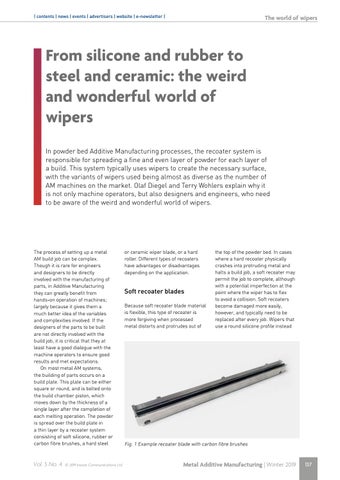| contents | news | events | advertisers | website | e-newsletter |
The world of wipers
From silicone and rubber to steel and ceramic: the weird and wonderful world of wipers In powder bed Additive Manufacturing processes, the recoater system is responsible for spreading a fine and even layer of powder for each layer of a build. This system typically uses wipers to create the necessary surface, with the variants of wipers used being almost as diverse as the number of AM machines on the market. Olaf Diegel and Terry Wohlers explain why it is not only machine operators, but also designers and engineers, who need to be aware of the weird and wonderful world of wipers.
The process of setting up a metal AM build job can be complex. Though it is rare for engineers and designers to be directly involved with the manufacturing of parts, in Additive Manufacturing they can greatly benefit from hands-on operation of machines; largely because it gives them a much better idea of the variables and complexities involved. If the designers of the parts to be built are not directly involved with the build job, it is critical that they at least have a good dialogue with the machine operators to ensure good results and met expectations. On most metal AM systems, the building of parts occurs on a build plate. This plate can be either square or round, and is bolted onto the build chamber piston, which moves down by the thickness of a single layer after the completion of each melting operation. The powder is spread over the build plate in a thin layer by a recoater system consisting of soft silicone, rubber or carbon fibre brushes, a hard steel
Vol. 5 No. 4 Š 2019 Inovar Communications Ltd
or ceramic wiper blade, or a hard roller. Different types of recoaters have advantages or disadvantages depending on the application.
Soft recoater blades Because soft recoater blade material is flexible, this type of recoater is more forgiving when processed metal distorts and protrudes out of
the top of the powder bed. In cases where a hard recoater physically crashes into protruding metal and halts a build job, a soft recoater may permit the job to complete, although with a potential imperfection at the point where the wiper has to flex to avoid a collision. Soft recoaters become damaged more easily, however, and typically need to be replaced after every job. Wipers that use a round silicone profile instead
Fig. 1 Example recoater blade with carbon fibre brushes
Metal Additive Manufacturing | Winter 2019
137
